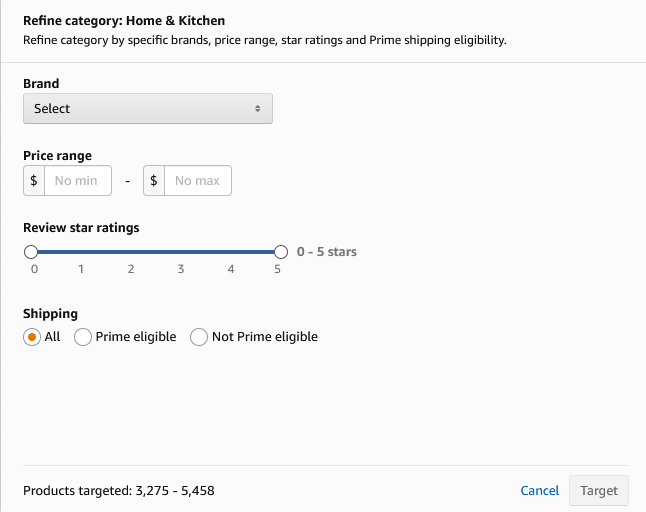Pay-per-click advertising is the greatest weapon you have in your arsenal as an eCommerce Amazon seller. Of course, your product is the star and what ultimately gets you sales. However, using the Amazon PPC system properly is what truly maximizes your product’s potential.
Keep in mind that PPC is not only there to secure sales from people who click on your ads. Getting PPC sales increases both your organic rankings and your product’s real estate on the Amazon platform. PPC is the most effective tool you can use to rise up in searches as well as see who is higher up in more searches.
Every Amazon seller has some sort of PPC structure that can vary greatly in size and complexity. This is usually dependent on the size of a seller’s product catalog or understanding of the PPC mechanisms available.
Amazon keeps adding new options and methods for refining campaigns, which can be used to adjust your structure in more profitable ways. We are going to go through several different things you can do right now to your PPC structure in order to improve it. Or at the very least, identify new potential avenues of growth.
Use the Right Keywords
This is basic advice that most sellers are already aware of. What most eCommerce Amazon sellers don’t do is take a look at the search volumes of their top keywords or general volumes of the top search keywords at any given point in time. The truth is that those search volumes can change and new searches can show up, and these new ones can be used in your campaigns. This is why it’s wise to use tools like the AMZScout Amazon keyword tools to regularly look into the volumes of searches that are most relevant to you. You can use tools like this to both look into searches that contain any keyword you are interested in general as well as check which keywords your competitors are ranking on.

With more advanced tools like the AMZScout Keyword tracker, you can even keep track of your organic rankings in order to evaluate the effect your PPC campaigns are having.

This is a crucial insight that can help you to best organize your PPC efforts and invest more spending in targets that can secure you more organic sales in the future. Overall, you can never have enough information when it comes to keywords.
Utilize Your Auto Campaigns Fully
The way auto campaigns work has been significantly updated in the past year. There are several new options that many sellers are not aware of. Previously, the main issue with auto campaigns was the fact that you had so little control over them. The only thing you could do was include negative keywords and control the default bids. Now you have many more options.
With the major addition of a manual product targeting option, the auto campaign option has also been adjusted to accommodate the new option to target specific ASINs manually. On top of this, there are now four different targeting options for auto campaigns:

You have two distinct keyword targeting options as well as two product or ASIN options:
- Close and loose matches: Keyword targeting options that target either search terms closely related to your type of product or a set of more general search terms.
- Substitutes and complements: The two ASIN targeting options that are either targeting the exact same type of product, your direct competitors, or products that are complementary and might be purchased by a customer in the same realm of interest.
A good way to utilize these new targeting options would be to create either separate auto campaigns or ad groups that can target the two types of targets separately. This is because you can allocate proper budgets and have more workable reports. Having them separate is also useful if one type of targeting is not working so that you can abandon or temporarily pause it while maintaining the other one. This also gives you separate negative targeting options.
Now, you can enter negative keywords and negative product targets. This option was added much more recently. If your product targeting auto campaigns haven’t worked out in the past, they might be more viable now – since, before this, you couldn’t properly add a negative product target.
Moving Targets to a More Precise Campaign
One thing that any seller should be doing regularly is extracting reports and targets that got hits in auto campaigns or any other non-exact campaign and moving them to more precise targeting. You should have separate campaigns that only serve this purpose. When you find an ASIN target that received a hit from an auto campaign or any phrase or broad campaign, you should have two separate single ASIN and exact match type targeting campaigns where you can move over those newly-found keywords and test them to see whether they can bring you more consistent sales.
Use Refined Niche Targeting
Apart from the option to target individual ASINs that you can pick out by hand, as well as have the ASIN targeting options in your auto campaigns, there is another type of targeting that can be fine-tuned even more. This is product targeting based on categories. This is the most versatile type of targeting and is based on ASINs. However, when you go into the settings for the manual product targeting campaign, you have the ‘refine’ option:

The options here are very precise and allow you to really segment the type of products you want to target by several criteria. You can target products in a certain price range, certain brands, or exclude them. You can target products by rating and prime eligibility. This allows your product category targeting campaigns to have virtually endless experimentation options. If you put in enough effort, you are bound to find a way to target at least a single category in such a way that you can have a consistent influx of sales.
Adjust Bids Based on Placements
Sponsored ads can show up on any page of any search and naturally, the ones with the higher bids get higher spots. Of course, there is no guarantee that with a higher bid your ad will show up on the front page. Amazon has recently added the option of allowing your bids to increase by a certain percentage if this guarantees that they will show up on page 1.

This can be useful when it comes to taking an aggressive marketing approach. If you are looking to really make headway with some highly relevant keywords, it could be a good idea to use this mechanism. Keep in mind that this applies only on a campaign level so you cannot pick and choose which keywords to boost in order to get the page 1 impressions.
This is why it can be wise to be specific and use only a handful of keywords in a single campaign, or even a single keyword if you are trying to get higher rankings within a particular search. This approach can be expensive, so make sure to use it cautiously. It is also a high reward since if you find a keyword or set of keywords that can convert well on high bids and consistently show up on page one, you are bound to secure some substantial organic ranking and long-term organic sales.
Adjust Your Bids Regularly and Use the Suggested Bids as a Reference
There are constant shifts in the way Amazon behaves, especially now, deep in the fourth quarter with sales, in general, going up. You cannot hope to tackle any development or shift if you do not pay attention to your bids. One of the best ways to make sure your bids are set in the most cost-effective way is to adjust them according to both performance and suggested bids. Suggested bids give you an insight into how much your competitors are spending. A good rule of thumb is to keep an eye on the total impressions you are getting week by week, both on the entirety of your PPC structure as well as crucial keywords.
—
In conclusion, having a healthy and well-optimized PPC structure is a must-have for any serious Amazon seller. There is no such thing as a fully optimized PPC structure that you can simply let run and hope for the best results. Your PPC structure needs constant maintenance. Make sure to extract reports regularly, move targets, and do regular keyword research.
A very important aspect of the Amazon PPC system is constant additions and new mechanisms. It is your duty to understand any recent change that comes in and do your best to find a way to make it work for your product and relevant targets. Experimentation is vital when it comes to PPC and the only way to explore and hopefully discover new avenues of growth and streams of sales.
For more tips on Amazon eCommerce visit these top posts:
- How to Increase Your Amazon Seller Feedback Rating
- 5 Pricing Strategies Every Amazon Seller Needs to Know

Nicole Blanckenberg
Nicole is a content writer at StoreYa with over sixteen years experience and flair for storytelling. She runs on a healthy dose of caffeine and enthusiasm. When she’s not researching the next content trend or creating informative small business content, she’s an avid beachgoer, coffee shop junkie and hangs out on LinkedIn.
Comments
comments
Powered by Facebook Comments





